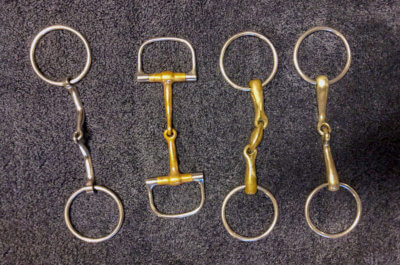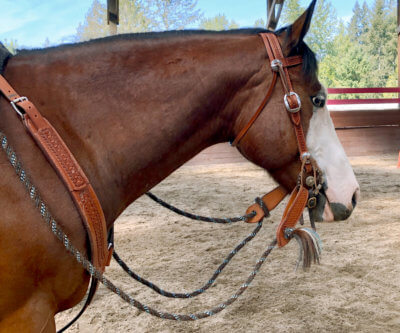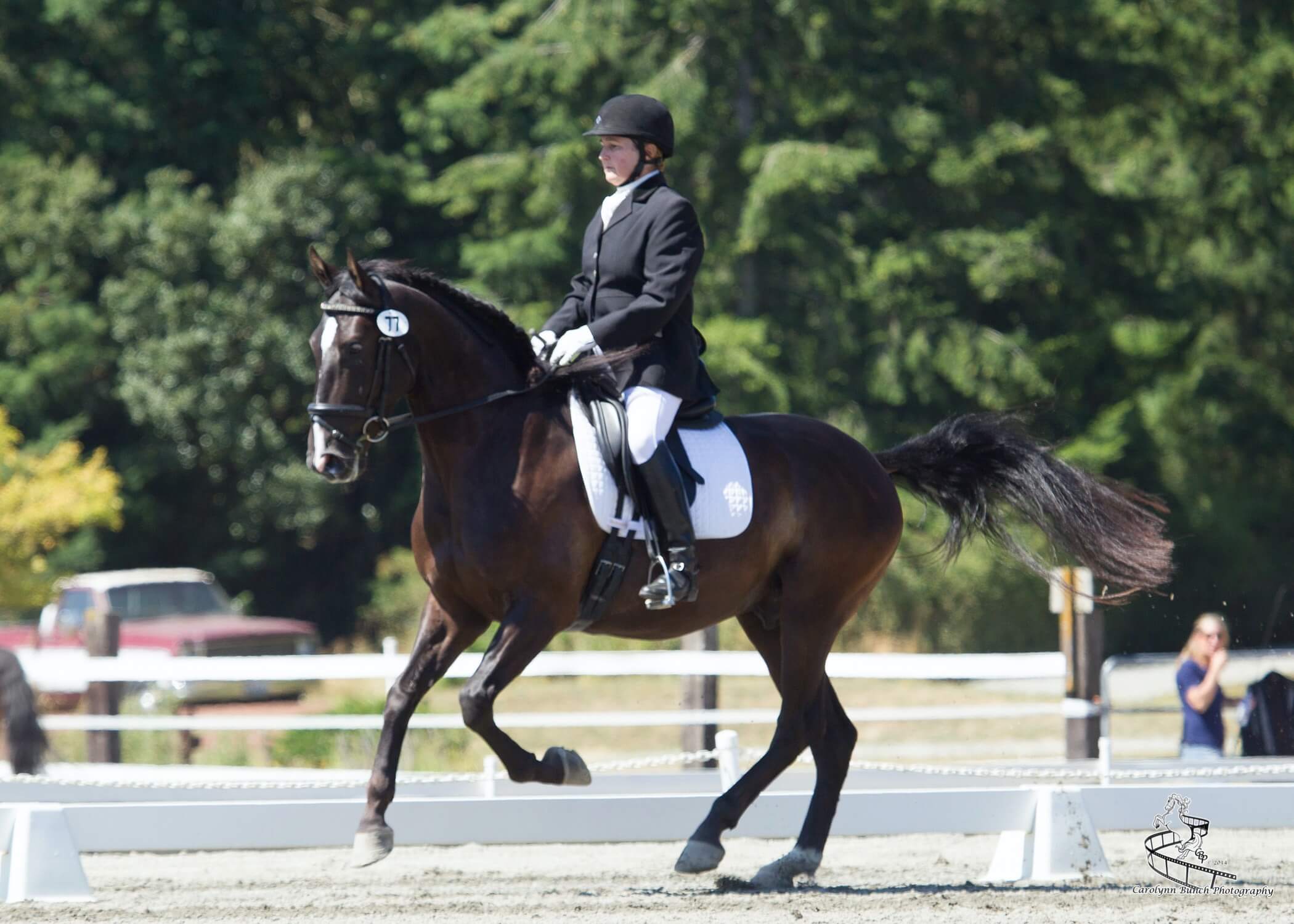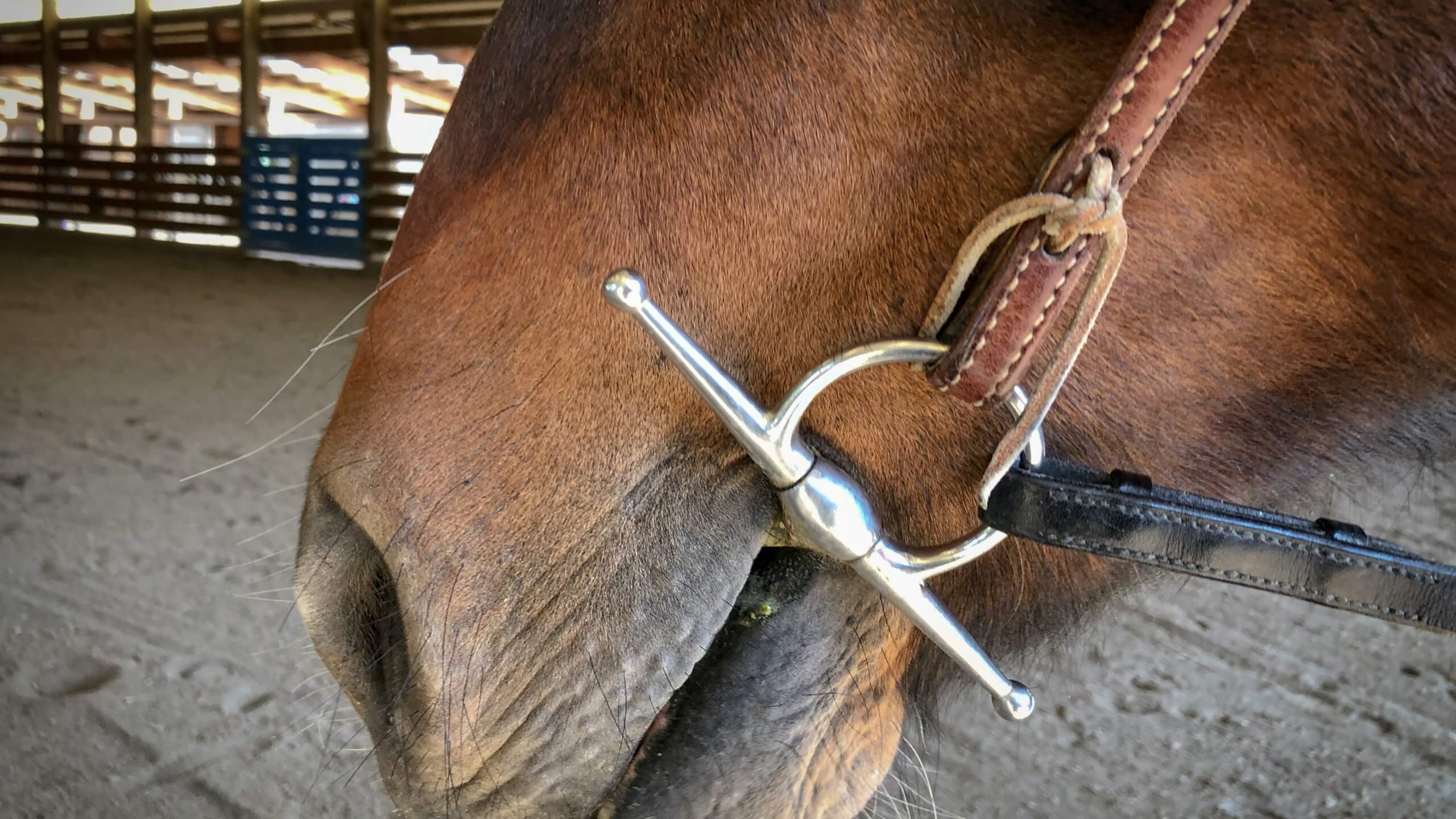Walk into any horse trainer’s tack room and you’re likely to find more than one kind of snaffle bit. Developed thousands of years ago, the snaffle is the most useful bit for daily training for horses of all levels. The snaffle bit is used by horsemen of all disciplines—from racing to western pleasure, reining to dressage.
The snaffle bit works without leverage, so the actions of the reins (and the rider’s hands) work directly on the mouth of the horse. This direct pressure creates flexion and bend in the poll and neck and also clearly indicates to the horse which way to go or turn. This straightforward pressure makes the snaffle the best choice for starting young horses and refining the education of older horses.
Unlike shanked bits that use leverage against the horse’s poll and chin groove, snaffles work on the corners and bars of the horse’s mouth as well as on the tongue and roof of the mouth. Different parts of the mouth receive more or less pressure depending on the shape of the bit. A straighter mouthpiece puts more pressure on the horse’s tongue, whereas one that has more curve to the mouthpiece puts the pressure more on the corners of the lips and on the bars.
 Bit makers have developed snaffles that come in many shapes and sizes and are made out of a variety of metals, rubber, and plastics. There are D-rings, loose rings, full cheek, etc. and each bit can have a different kind of mouthpiece. Snaffles can have one link, two (double-jointed snaffle), or none (mullen mounth). They can have rollers over the links, twisted wire, copper inlay and more.
Bit makers have developed snaffles that come in many shapes and sizes and are made out of a variety of metals, rubber, and plastics. There are D-rings, loose rings, full cheek, etc. and each bit can have a different kind of mouthpiece. Snaffles can have one link, two (double-jointed snaffle), or none (mullen mounth). They can have rollers over the links, twisted wire, copper inlay and more.
The variety of bits has arisen due to horses’ preference that mostly depends on the conformation of their mouth—hence, multiple snaffles are often found hanging in a trainer’s tack room. Also, disciplines have diverse goals in training, so trainers need differently shaped snaffle bits that help them achieve their specific goals. Here’s a list of some of the more common snaffles:
Loose ring snaffles have an O-ring that slides around the mouthpiece. These bits have more play in them and make it harder for the horse to “lean” on the bit. If it has two links it will be even more slippery in the horse’s mouth and also stops the “nutcracker” action of a single-jointed snaffle.
A loose ring snaffle puts less direct pressure against a horse’s mouth. It’s a great bit for a horse that might be a little dead in the mouth as it will encourage the horse to use his tongue and release his jaw, like someone sucking on a piece of hard candy. The downside is that a loose ring snaffle can pinch the corners of the horse’s mouth, so the correct size is important. It can also be used with bit guards (plastic or leather inserts that prevent the bit from pinching).
Egg butt snaffles rest securely in the horse mouth. The rings don’t rotate at the horse’s cheek and so it has limited motion and won’t pinch their lips. It’s a good bit for many horses.
D-ring snaffles have a cheekpiece shaped like a D. These bits have little movement in the horse’s mouth, won’t pinch the corners of the horse’s lips, and encourages the horse to “take” the bit, so it’s good for horses that get behind the bit, curl, or fear contact. Historically a preferred bit for racehorses and hunters, it’s not always so good for a horse that braces in the neck or poll. The D’s also prevent the bit being pulled through the mouth.
Full cheek snaffles, like D-ring snaffles, are a secure bit with little movement. The straight cheekpieces work to “push” the horse into the turn or flexion from the outside and the bit won’t pull through a horse’s mouth. They are commonly used with a headstall that has a keeper for the cheekpiece to keep it even more steady and keep the bit from rolling forward in the horse’s mouth. The full cheek snaffle is a good bit for starting horses.
Mullen mouth snaffles are a straight bar in the horse’s mouth. They are good for horses who are very sensitive to movement and who resist the action of the bit against the roof of their mouth. They’re less commonly used as horses will lean into it.
Which Bit is Best?

While no snaffle can be labeled “best”, many trainers and disciplines have strong preferences. It’s worth it to try more than one bit if your horse is having mouth or contact issues. Horses’ mouths are shaped differently—so believing one bit will work for all horses is foolish. Some horses prefer more pressure on the tongue, others on the bars, and still others can only tolerate the corners of their mouth touched. Don’t make the mistake of thinking that because one horse works well in a certain type of snaffle that all horses will love that bit.
Bits become trendy, especially within disciplines, to the point that every horse in a class at a horse show will have the exact same style of bit. In reality, riders need to choose bits that their horse goes well in and promotes relaxation in the mouth and neck.
Bits come in a variety of metals too. Copper tends to promote a “wet” mouth because it causes the horse to salivate. “Sweet iron” is a kind of steel that rusts, seems to have a taste that many horses prefer and work well in. Stainless steel is fairly neutral in its taste; again, some horses prefer this.
It’s also important to know the snaffle size you need for a horse. Measured from ring to ring, most horses wear between a 4.5-inch (smaller horse) to a 6-inch (large horse) with 5-inch probably the most common.
Finally, it’s worth noting that a snaffle bit should never be pulled straight back on. Snaffles should be used to laterally flex the poll, jaw, and neck of the horse with more of a lifting action.
Generally, a thick mouthpiece is a gentler bit while a narrower one will have more “bite” to it. But in the end, the hands holding the reins can make any bit intolerable. Remember, the most important part of the bit is the person holding the reins.
See this article in the June 2021 online edition:

Kim Roe grew up riding on the family ranch and competed in Western rail classes, trail horse, reining, working cow, and hunter/jumper. She trained her first horse for money at 12 years old, starting a pony for a neighbor.
Kim has been a professional dressage instructor in Washington state for over 30 years, training hundreds of horses and students through the levels. In recent years Kim has become involved in Working Equitation and is a small ‘r’ Working Equitation judge with WE United.
Kim is the editor of the Northwest Horse Source Magazine, and also a writer, photographer, and poet. She owns and manages Blue Gate Farm in Deming, Washington where she continues to be passionate about helping horses and riders in many disciplines.






